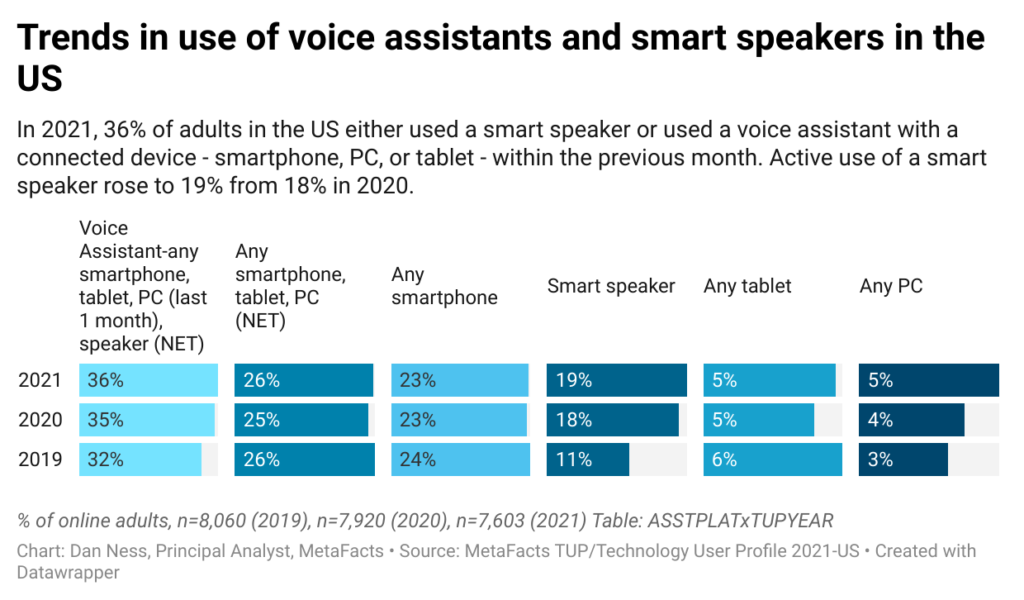Home is where the fun is, enhanced by VR headsets, game consoles, smart speakers, smartphones, tablets, and computers. Home entertainment using technology devices and services is dominated by younger adults and parents, although not entirely so.
This TUP Highlights report includes the following sections: the profile of home entertainment users, home entertainment devices, and home entertainment trends.
Highlights: Wearables, Hearables, Listening & Speaking
Entertainment, communication, and smart homes have all evolved beyond requiring typing on a keyboard or sitting near PC speakers. Wearable and hearables have extended a broad range of audible activities further towards a more personal convenience. However, active usage of any wearables or hearables has varied considerably across market segments. While Bluetooth headphones are widespread, VR headsets persist as niche products among a younger, more affluent, and tech-savvy segment. Smart speakers, in contrast, are showing signs of having peaked after rising in use among a middle market.
This TUP Highlights report includes the following sections: wearables penetration, hearables penetration, wearable devices used, trends in wearables and hearables, purchase plans for wearables, listening activities, penetration of voice assistant usage, the profile of voice assistant users, the profile of hearables users, and the profile of wearables users.
Highlights: Consumer Electronics
Hearables are having a tumultuous time during the pandemic, and users adapt to shifting situations. Webcams are a significant force, as are wireless Bluetooth headsets, both pivotal for users working or schooling from home. Meanwhile, voice-enabled speakers have reached a plateau, reaching their largest share among neither the youngest nor oldest adults. Smartwatches have made inroads across nearly all age groups, especially younger employed adults.
This TUP Highlights report includes the following sections: purchase plans for wearables, hearables penetration, wearables penetration, trends in consumer electronics, the profile of hearables users, the profile of wearables users, the profile of key consumer electronics users, and device activities compared to consumer electronics.
Trends in voice assistant usage
Voices have the promise to enable a keyboard-free digital experience, and yet regular usage has not reached even half of the population. This MetaFAQs reports on the percentage of online adults in the US, Germany, UK, and Japan that regularly use a voice assistant or smart speaker.
Profile of voice assistant users
Using our voice offers the chance to get things done without typing when using a smart speaker or another connected device – smartphone, PC, or tablet. However, current usage has not reached even half of the population. This MetaFAQs reports on the percentage of online adults in the US, Germany, UK, and Japan that regularly use a voice assistant or smart speaker, detailed by age group.
Breadth of voice assistant usage
Dan Ness, Principal Analyst, MetaFacts, December 13, 2021
Actively using a voice assistant or smart speaker
- This analysis focuses on those people who are actively using a voice assistant or smart speaker
- Have used a connected device to use a voice assistant within the previous month
- Smartphone, PC, or tablet
- Have a smart speaker
- Have used a connected device to use a voice assistant within the previous month
- Base: all online adults
Active voice assistant usage by platform – US
- The overall use of a voice assistant or smart speaker has only slightly increased between 2019 and 2021
- Smart speaker usage has grown the most among American online adults, rising from 11% in 2019 to 19% in 2021
- Voice assistant usage with other connected devices has not changed markedly
- Voice assistant usage with a smartphone continues to outpace smart speaker use

Smart speakers more talk than action? Voice assistants across platforms [TUPdate]
Dan Ness, Principal Analyst, MetaFacts, October 19, 2018 Convenience is the surest bet to reach technology consumers. When it comes to voice assistants, convenience must be handy. It shouldn’t be surprising that consumers first choose what’s familiar and close to hand. More are actively speaking to devices they’ve already had before using smart speakers. Among…
Voice assistants-does age matter? [MetaFAQs]
Dan Ness, Principal Analyst, MetaFacts, March 13, 2018 Age matters when it comes to voice assistant use, and it’s overly simplistic to say that they’re mostly being used by younger adults. Yes, there’s a strong age difference between active voice assistant users, former users, and those who’ve never even given one a try. Age by…
Voice assistants-what users ask about [MetaFAQs]
Dan Ness, Principal Analyst, MetaFacts, March 9, 2018 As the saying goes, many talk about the weather, yet few do anything about it. Our research doesn’t show if people expect Alexa to have any skills to do anything about the weather. However, it is the main subject users speak with Alexa about. That’s followed by…
Voice assistants-What’s listening now? [MetaFAQs]
Dan Ness, Principal Analyst, MetaFacts, March 1, 2018 Among voice assistant users, Apple AirPods have the most recent use of a listening device, with 78% having used it on the day we surveyed them. This high active-usage rate is closely followed by Apple notebooks or desktop Macs. Android smartphones rank last for this most-recent-use measure,…

